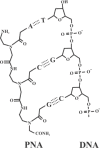Potential of Peptide Nucleic Acids in Future Therapeutic Applications
- PMID: 30607328
- PMCID: PMC6311635
- DOI: 10.15171/apb.2018.064
Potential of Peptide Nucleic Acids in Future Therapeutic Applications
Abstract
Peptide nucleic acids (PNA) are synthetic analog of DNA with a repeating N-(2-aminoethyl)-glycine peptide backbone connected to purine and pyrimidine nucleobases via a linker. Considering the unique properties of PNA, including resistance to enzymatic digestion, higher biostability combined with great hybridization affinity toward DNA and RNA, it has attracted great attention toward PNA- based technology as a promising approach for gene alteration. However, an important challenge in utilizing PNA is poor intracellular uptake. Therefore, some strategies have been developed to enhance the delivery of PNA in order to reach cognate site. Although PNAs primarily demonstrated to act as an antisense and antigene agents for inhibition of transcription and translation of target genes, more therapeutic applications such as splicing modulation and gene editing are also used to produce specific genome modifications. Hence, several approaches based on PNAs technology have been designed for these purposes. This review briefly presents the properties and characteristics of PNA as well as different gene modulation mechanisms. Thereafter, current status of successful therapeutic applications of PNA as gene therapeutic intervention in different research areas with special interest in medical application in particular, anti-cancer therapy are discussed. Then it focuses on possible use of PNA as anti-mir agent and PNA-based strategies against clinically important bacteria.
Keywords: Antigene; Antisense; Cancer; Gene Therapy; Peptide Nucleic Acid; Splicing.
Figures
References
-
- Raoof JB, Ojani R, Golabi SM, Hamidi-Asl E, Hejazi MS. Preparation of an electrochemical PNA biosensor for detection of target DNA sequence and single nucleotide mutation on p53 tumor suppressor gene corresponding oligonucleotide. Sens Actuators B Chem. 2011;157(1):195–201. doi: 10.1016/j.snb.2011.03.049. - DOI
Publication types
LinkOut - more resources
Full Text Sources
Other Literature Sources






